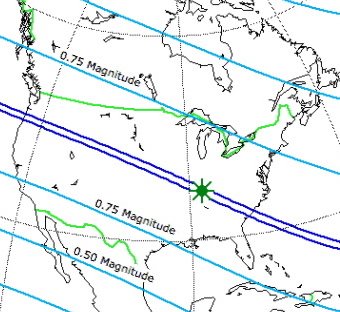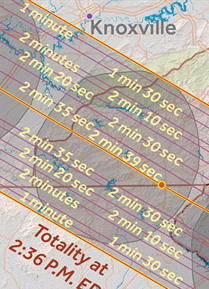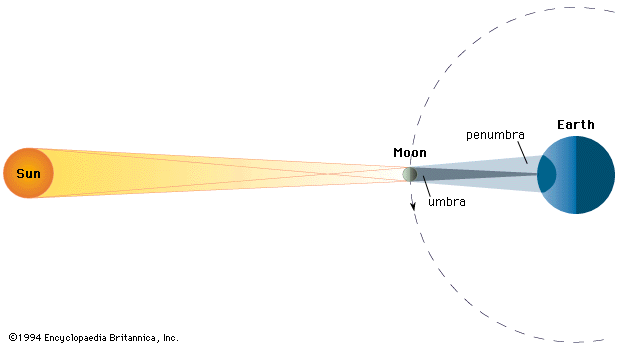 Science
Science
 Astronomy
Astronomy
 Eclipses
Eclipses

Don's Home
 Science
Science
 Astronomy
Astronomy
 Eclipses
Eclipses

|
|
Contents: Overview: | Cities (magnitude): | Information: | Weather:| Viewing: | Effect on Animals: | Terms: | Links:
Overview: The next total eclipse visible from the U.S. will be in April 2024 visible from Texas to Maine.
A solar eclipse occurs when the moon passes between the sun and earth casting a shadow on the earth.
While the Sun is actually about 400 times larger in diameter than the Moon, the Moon is also about 400 times closer than the Sun. Therefore, the Sun and the Moon appear to be about the same size in our sky.
This single fact explains why we see total solar eclipses - the Moon has an apparent size that just barely covers the Sun completely, yet is not too large that the Sun's atmosphere, its corona, is eclipsed as well.
Cities (magnitude):
| ||

|
Magnitude Albuquerque 0.78 Atlanta 0.97 Boston 0.70 Charlotte 0.98 Charlottesville 0.88 Chicago 0.89 Dallas 0.80 Denver 0.93 Houston 0.73 Lake Tahoe 0.84 Los Angeles 0.69 Miami 0.82 Minneapolis 0.86 | Nashville 1.02 New York City 0.77 Philadelphia 0.80 Phoenix 0.70 Portland, OR 0.99 Portland, ME 0.67 Salem, OR 1.01 Saint Louis 1.00 San Antonio 0.69 San Francisco 0.80 San Diego 0.66 San Jose 0.79 Seattle 0.93 Washington DC 0.85 |
Source: Eclipse Calculator – Eclipses in USA (City lookup)
Click on images below for interactive version | ||
|
Information: - Begins: Pacific coastline of Oregon at 17:16 UT1 (10:16 am PDT). Totality lasts 1 minute 59 seconds. The path of totality is 62 - 71 miles wide. - The time of totality is longest in the center of the path and gets shorter at the edges. - Maximun duration 2 min. 40 sec. in Kentucky. - Greatest Eclipse is 20 kilometres northwest of Hopkinsville, KY. Eclipse magnitude here is 1.03 (i.e. it completely covers the sun) - It passes thru Murphy, in SW North Carolina near the Tennessee border. - It passes between Greenville and Anderson SC at 19:39 UT1 (2:39 pm EDT) - The duration from the cities is 2 minutes 11 seconds and 2 minutes 34 seconds, respectively. - Columbia, SC is to the southeast and has a duration of 2 minutes 30 seconds. - Just inside the southern limit is historic Charleston. The duration 1 minute 29 seconds. It moves from 2,200 MPH to 1,500 MPH. | 
| |
|
Weather:
Apps: Viewing: Warning: Permanent eye damage can result from looking at the disk of the Sun directly, or through a camera viewfinder, or with binoculars or a telescope even when only a thin crescent of the Sun or Baily's Beads remain.
Permanent damage to the retina has been shown to occur in as little as a minute and a half.
The moment you begin looking at the sun, you start to develop a sunburn on your the cornea (eyeball), known as photokeratitis.
During the short time when the moon completely obscures the sun - known as the period of totality - it is safe to look directly at the star, but it's crucial that you know when to take off and put back on your glasses.
You can get the same effect by looking at the shadow of a colander.
See: Eye protection for observing an eclipse: Reputable Vendors of Solar Filters & Viewers | American Astronomical Society (AAS)  Paper ISO 12312-2 certified glasses (block out 100% of harmful UV and infrared as well as 99.999% of intense visible light) can be found for $1.00 *.
Paper ISO 12312-2 certified glasses (block out 100% of harmful UV and infrared as well as 99.999% of intense visible light) can be found for $1.00 *.Most are paper with silver coated mylar or scratch resistant optical density 5, "Black Polymer" lenses. You can put them under or over prescription lenses.
Availability:
Many libraries have them which they will distribute on a frist come first serve basis on Monday. Listen to the NPR report on eye protection with Ralph Chou, professor emeritus of optometry and vision science at the University of Waterloo, who's a leading authority on eye damage from eclipse viewing. Effect on Animals: There have been stories of strange animal behavior during an eclipse. Reports from 2015 partial eclipse in London: Many of the common birds stop singing and some may move to higher perches or more secluded spots to feel safer. Dogs looked confused. There were reports of pet dogs howling and running around on Twitter, although Battersea Dogs and Cats Home in London 'saw absolutely no changes in behaviour in our animals'. Read more: How did YOUR pets respond to the eclipse? | Daily Mail Online Solar Eclipse and pets: How will the solar eclipse affect your pet | ACJ com FAQ: Terms: - Baily’s beads - For a few seconds at the beginning and end of total solar eclipse, the thin slice of the Sun visible appears broken up into beads of light. Mountains and valleys on the Moon allows beads of sunlight to shine through in some places, and not in others.  - Diamond Ring - About 15 seconds before the moon completely covers the sun and after it leaves the sun, only a tiny crescent of sunshine is left and the sun’s faint upper atmosphere, or corona, begins to come into view. Around this time, the sliver of bright sunlight transitions into a stunning burst of radiance concentrated in one region along the sun’s edge.
- Diamond Ring - About 15 seconds before the moon completely covers the sun and after it leaves the sun, only a tiny crescent of sunshine is left and the sun’s faint upper atmosphere, or corona, begins to come into view. Around this time, the sliver of bright sunlight transitions into a stunning burst of radiance concentrated in one region along the sun’s edge.- Eclipse Magnitude is the fraction of the Sun's diameter covered by the Moon at greatest eclipse. - Greatest eclipse - Greatest eclipse is defined as the instant when the axis of the Moon's shadow cone passes closest to Earth's center. This occurs near Hopkinsville, KY where the magnitude will be 1.02. - Lunar Limb is the edge of the visible surface of the Moon as viewed from Earth - Penumbra - The penumbra is the weak or pale part of the Moon's shadow, where the sun is only partially blocked. - From within the penumbra, the Sun is only partially blocked by the Moon as in the case of a partial eclipse. This contrasts with the umbra, where the Sun is completely blocked resulting in a total eclipse. - Umbra - The umbra is the darkest part of the Moon's shadow. From within the umbra, the Sun is completely blocked by the Moon as in the case of a total eclipse. In the 2017 eclipse this is 70 miles wide. - 
Links: Eclipse2017 | Page 2 | Total Solar Eclipse 2017 Solar Eclipse Across America - August 21, 2017 | American Astronomical Society Eclipse2017 | Total Solar Eclipse 2017 | NASA.gov 2017 Eclipse: Earth, Moon and Sun | Scientific Visualization Studie (SVS), NASA EclipseWise - Solar and Lunar Eclipses Eclipse Calculator - Eclipses in USA | TimeandDate.com MrEclipse.com How to Photograph a Solar Eclipse Return to Eclipses
| ||